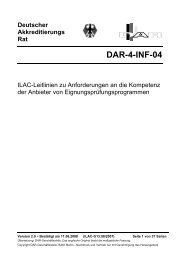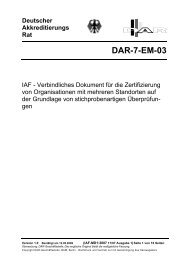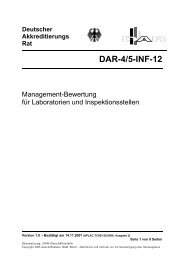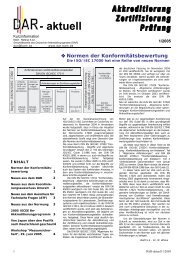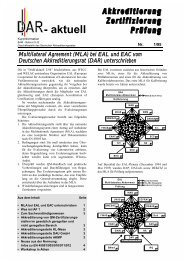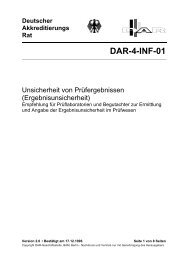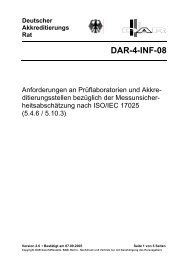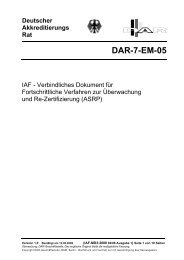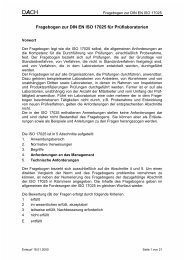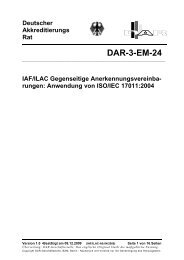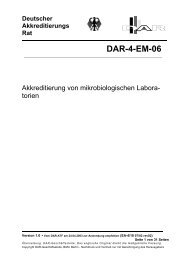EA-5/01 - Sanas
EA-5/01 - Sanas
EA-5/01 - Sanas
You also want an ePaper? Increase the reach of your titles
YUMPU automatically turns print PDFs into web optimized ePapers that Google loves.
<strong>EA</strong>-5/<strong>01</strong>. <strong>EA</strong> Guidance on the application of <strong>EA</strong> (ISO/IEC 17020)<strong>EA</strong> Guidance to clause 1.4G1.2 A list of European Standards used for accreditation of test laboratories,product certification and quality system certification is given in the Introductionto EN 45004. Some standards may be out of date or have been revised sinceEN45004 was produced and therefore reference should be made to the latestversion of these standards. The standards and versions in use when theseguidelines were produced are listed in APPENDIX 4 to this document.G.1.3 Testing performed by an inspection body may fall under 2 categories namelyfunctional and analytical. Functional testing, for example load testing of acrane, forms a normal part of the activities of an inspection body and istherefore within the scope of EN45004. Analytical testing, for examplechemical or metallurgical analysis, is a laboratory activity and therefore doesnot come within the scope of EN45004. Inspection bodies wishing toundertake such laboratory type analytical testing as part of an inspection willneed to do so in accordance with the relevant requirements in EN ISO/IEC17025.2 DEFINITIONS<strong>EA</strong> Guidance to clause 2.1G2.1 The definition of inspection overlaps with that of testing and productcertification where these activities have common characteristics. However, animportant difference is that many types of inspection involve professionaljudgement to determine acceptability against general requirements and thusthe inspection body will have to demonstrate that it has the necessarycompetence to perform the task.G2.2 Generally, inspection involves direct determination of the conformance withspecific or general requirements of unique - often complex or critical - productsor small series of products, whereas product certification primarily involvesindirect determination of the conformance of products manufactured in longseries to specific requirements. While inspection of products in use (in-serviceinspection) is a well-established discipline, certification (EN 45<strong>01</strong>1) of productsin use does not occur. Some further differences are shown in the followingtable.SOME DIFFERENCES BETWEEN INSPECTION (EN 45004) AND PRODUCTCERTIFICATION (EN 45<strong>01</strong>1)Activity Inspection Product CertificationInspection of individual Certification of series ofNature of operationproducts, and notproducts and always by thirdnecessarily by third party party (indirect determination(direct determination of of conformance)November 2003– rev.02 Page 5 of 22
<strong>EA</strong>-5/<strong>01</strong>. <strong>EA</strong> Guidance on the application of <strong>EA</strong> (ISO/IEC 17020)ConformityAssuranceDecisionsIssuing of licensesMarking of productsSurveillanceIn-service inspection ofproductsconformance)Examined against standardsor other Normativedocuments and/or generalrequirementsReport provides condition atthe time of inspectionNo need for separation ofthose taking inspectiondecisions from thoseperforming inspectionNo licenses issuedMarks put only on productscovered by inspectionOnly where required in orderto support inspectionAlways by inspectionAssessed against standardsor other NormativedocumentsCertification normallyprovides continuingassurance of complianceCertification decisions takenby a different person(s) fromthose who have carried outevaluationGrants licence to supplier toissue certificate or put marksMarks may be put on acertified product underlicenceNormally necessary toprovide continuing assuranceof complianceNot by product certificationG2.3 The scope of EN45004 does not cover quality management systemcertification. It may, however, be necessary for inspection bodies to examinecertain aspects of the quality management system in order to justify theinspection results, for example, the examination of processes.3 ADMINISTRATIVE REQUIREMENTS<strong>EA</strong> Guidance to clause 3.2G3.1 The identity of the inspection body within the organisation could be shown inan organisation chart.<strong>EA</strong> Guidance to clause 3.3G3.2 Accreditation bodies present the scope of activity for which accreditation ofinspection bodies is granted in a formal statement, called the AccreditationSchedule that accompanies the Accreditation Certificate. The AccreditationSchedule is produced by the accreditation body in consultation with theassessor(s) involved in the assessment of the inspection body. It is based oninformation provided by the inspection body in connection with the applicationfor accreditation. The Accreditation Certificate and Schedule should indicatethe type of body as defined in subclause 4.2 of EN 45004. An example of aNovember 2003– rev.02 Page 6 of 22
<strong>EA</strong>-5/<strong>01</strong>. <strong>EA</strong> Guidance on the application of <strong>EA</strong> (ISO/IEC 17020)• Type B inspection bodies form a demonstrably separate andidentifiable part of an organisation that is involved in the design,manufacture, supply, installation, use or maintenance of itemsthat they inspect;• Type B inspection bodies supply inspection services only to theirparent organisation.A Type B inspection body may form a part of a user organisation or of asupplier organisation.• When a Type B inspection body that forms a part of a supplierorganisation inspects items that are manufactured by or for itsparent organisation and are to be supplied to the market or toany other party, it carries out first party inspection.• When a Type B inspection body that forms a part of a userorganisation inspects items to be supplied for use by its parentorganisation by a supplier organisation that is not its parentorganisation and not related to it, it carries out second partyinspection.G4.4 Type C inspection bodies are involved, in the design, manufacture, supply,installation, use or maintenance of items that they inspect. Inspections carriedout by them may include first party inspections and second party inspectionsof the same type as carried out by Type B bodies. However, Type C inspectionbodies are distinct from Type B inspection bodies for the following reasons:• A Type C inspection body need not be a separate part but shallbe identifiable within the organisation. A Type C body may itselfbe the designer, manufacturer, supplier, installer, user ormaintainer of items that it inspects.• A Type C inspection body may offer its inspection service on theopen market or to any other party and supply inspection serviceto external organisations. For example, it may inspect productssupplied by it or by its parent organisation and used by anotherorganisation. It may also supply other organisations withinspection of items that are similar to those designed,manufactured, supplied, installed, used or maintained by it or byits parent organisation, and which may therefore be regarded ascompetitive.Inspections carried out by Type C inspection bodies cannot be classified asthird party inspections because they do not meet the requirements ofNovember 2003– rev.02 Page 8 of 22
<strong>EA</strong>-5/<strong>01</strong>. <strong>EA</strong> Guidance on the application of <strong>EA</strong> (ISO/IEC 17020)5 CONFIDENTIALITY<strong>EA</strong> Guidance to clause 5G.5.1 The inspection body should have a policy, documented in its quality system,concerning the observance of the confidentiality requirements of the client bythe inspection body (cf. clause 12.3 of EN 45004) and by any sub-contractorsengaged by it (see clause 14 of EN 45004), taking into account the relevantlegal requirements. For mandatory inspection the procedures should set outwho besides the client is entitled to have access to the results.6 ORGANISATION AND MANAGEMENT<strong>EA</strong> Guidance to clause 6.1G6.1 In this clause the term organisation is understood as including the size,structure and composition of an inspection body which taken together shouldbe suitable for the competent performance of the tasks with which theinspection body is concerned.<strong>EA</strong> Guidance to clause 6.2G6.2 To meet the requirements of this clause the inspection body should maintainan up-to-date organisational chart clearly showing the functions and lines ofauthority for staff within the inspection body and the relationship, if any,between the inspection function and other activities of the organisation. Theposition of the technical manager (see clause 6.3 of EN 45004) in theorganisation should be clearly shown in the chart.G6.3 For each managerial and technical position in the organisation that could havean effect on the quality of inspections, details of responsibility should beincluded in the documentation (see clause 7.3 of EN 45004).G6.4 The degree of complexity of documentation and the extent to which staffmembers can hold several functions will depend upon the size of theorganisation.<strong>EA</strong> Guidance to clause 6.4G6.5 The inspection body should be able to demonstrate that it is organised in sucha way that the work of the staff performing inspections is supervised bypersonnel who are familiar with the objectives of the inspections, theinspection methods and procedures being used and the assessments of theinspection results. The extent, nature and level of supervision exercisedshould take in to account the qualifications, experience, training and technicalknowledge of the inspection staff and the inspections being undertaken.November 2003– rev.02 Page 10 of 22
<strong>EA</strong>-5/<strong>01</strong>. <strong>EA</strong> Guidance on the application of <strong>EA</strong> (ISO/IEC 17020)Competent outside bodies may carry out internal audits. As a rule, internalaudits should be arranged so that the quality system is examined at least onceper year. The internal audits should ensure that the guidance given in G6.7 ismet.<strong>EA</strong> Guidance to clause 7.9G7.4 Management reviews should take account of any relevant information, such asreports from supervisory and managerial staff, the outcome of recent internalquality audits and external assessments, complaints from clients, changesneeded in the quality system, the adequacy of current human and equipmentresources, future plans and estimates for new work, additional staff, as well asthe need for training of both new and existing staff. The frequency ofmanagement reviews should be determined by the inspection body, takingaccount of the results from internal audits and previous reviews and reportsfrom an accreditation body. Once a year is normally considered an acceptableminimum frequency.8 PERSONNEL<strong>EA</strong> Guidance to clause 8.1G8.1 Permanent personnel are those who are employed by or under contract to theinspection body. They may be employed either on a full-time basis or on apart-time basis. Where it is necessary to use personnel for temporarysituations, such personnel should be formally contracted for the period that theinspection body uses them. The inspection body should ensure that suchpersonnel are supervised and competent and that they work in accordancewith the inspection body’s quality system.<strong>EA</strong> Guidance to clause 8.2G8.2 Inspection body should define and document the qualifications, training,experience and the level of knowledge required for the inspections to becarried out (See also clause 6.6 of EN45004). Accreditation Body shouldassess the appropriateness of such qualifications, training, experience and thelevel of knowledge for the scope of inspections to be accredited.<strong>EA</strong> Guidance to clause 8.3G8.3 Inspection bodies may use competent external organisations for staff training.<strong>EA</strong> Guidance to clause 8.4G8.4 The purpose of these records is to demonstrate the competency of eachmember of the staff to perform specific inspection tasks and, where relevant,to use specific equipment.November 2003– rev.02 Page 12 of 22
<strong>EA</strong>-5/<strong>01</strong>. <strong>EA</strong> Guidance on the application of <strong>EA</strong> (ISO/IEC 17020)<strong>EA</strong> Guidance to clause 8.5G8.5 This guidance can be in the form of a code of conduct. It may include issuesrelating to work ethics, impartiality, personal safety, relationship withcustomers, company rules and any other issues needed to assure the properconduct of inspection body’s staff.<strong>EA</strong> Guidance to clause 8.6G8.6 The purpose of this clause is to prevent the potential for compromisinginspections as a result of financial inducement.9 FACILITIES AND EQUIPMENT<strong>EA</strong> Guidance to clause 9.1G9.1 The inspection body need not be the owner of the facilities or equipment that ituses. Facilities and equipment may under contract be borrowed, rented, hired,leased or provided by another party (e.g. the installer of the equipment). In allcases access to the equipment must be defined and meet the requirements ofEN 45004. However, the responsibility for the suitability and the calibrationstatus of the equipment used in inspection but not owned by the inspectionbody lies solely with the inspection body and cannot be delegated.G9.2 If controlled environmental conditions are needed and premises outside thoseof the inspection body are used, the inspection body should monitor theenvironmental conditions in these premises with calibrated equipment, recordthe results and note if conditions are outside the limits within which inspectioncan be performed.<strong>EA</strong> Guidance to clause 9.6G9.3 All equipment used for measurement and test where the results of suchmeasurements and tests have a significant influence on the results of theinspection, i.e. the conclusion about conformance with requirements, shouldbe treated as equipment that are appropriate for calibration.<strong>EA</strong> Guidance to clause 9.7G9.4 Where the calibrations are performed in-house, traceability to nationalstandards should be assured by using reference standards of measurementfor which the inspection body holds a current calibration certificate orequivalent from a competent body, as defined in the guidance to clause 9.8given below. The certificate or equivalent should detail an uncertainty ofmeasurement that is appropriate for the equipment that is to be calibratedfrom the reference standard. For further information on uncertainty ofNovember 2003– rev.02 Page 13 of 22
<strong>EA</strong>-5/<strong>01</strong>. <strong>EA</strong> Guidance on the application of <strong>EA</strong> (ISO/IEC 17020)measurement see EN ISO/IEC 17025 and <strong>EA</strong>-4/02, Expression of Uncertaintyof Measurement in Calibration.G9.5 Where the calibrations are performed by external suppliers, the suppliersshould be competent bodies as defined in the <strong>EA</strong> Guidance to clause 9.8given below.<strong>EA</strong> Guidance to clause 9.8G9.6 Accredited calibration laboratories of a country, its national standardslaboratory (or laboratories) and bodies that have been assessed by theinspection body using the relevant criteria of EN 45003 (ISO Guide 58) andhave been shown to meet all the requirements of EN ISO/IEC 17025should beregarded as competent bodies for the purpose of this clause. Equivalentlaboratories from other countries can also be used, provided that they have anestablished traceability of measurement. Such traceability of measurement isprovided by national metrology institutes participating in the work ofEUROMET and by laboratories accredited by bodies that are signatories tothe <strong>EA</strong> multilateral agreement on calibration.G9.7 Where the inspection body carries out assessment of external suppliers ofcalibration services itself, the inspection body should be able to demonstratethat it has the necessary competence to assess the performance of thecalibration activity concerned against all the requirements of EN ISO/IEC17025 in accordance with the relevant requirements of EN 45003(ISO Guide58). Inspection body should have procedures for conducting suchassessments and it should maintain records of such assessments.10 INSPECTION METHODS AND PROCEDURES<strong>EA</strong> Guidance to clause 10.1G10.1 The requirements against which the inspection is performed are normallyspecified in regulations, standards and specifications. Specifications mayinclude customer or in-house requirements. When the inspection methodsand procedures are not defined in regulations, standards and specificationsthe inspection body itself shall define the methods and procedures forinspection.G10.2 In certain circumstances the inspection body’s customer may supplyinformation to the Inspection Body to take into consideration when performingits inspection. If the inspection body uses such information supplied by anyother party as part of the inspection body’s determination of conformity, then itshould be able to demonstrate the measures taken to verify the integrity ofsuch information.<strong>EA</strong> Guidance to clause 10.3November 2003– rev.02 Page 14 of 22
<strong>EA</strong>-5/<strong>01</strong>. <strong>EA</strong> Guidance on the application of <strong>EA</strong> (ISO/IEC 17020)G10.3 A standard inspection method is one that has been published, for example, inInternational, Regional or National standards or by reputable technicalorganisations or by co-operation of inspection bodies or in relevant scientifictext or journals. This means that methods developed by any other means,including methods by the inspection body itself or by the customer, areconsidered to be non-standard methods.G10.4 Appropriateness of non-standard methods or procedures implies that theireffectiveness has been demonstrated.<strong>EA</strong> Guidance to clause 10.8G10.5 Documented procedures should include, precautions for the safety ofpersonnel, and where appropriate, protection of the surrounding environment.11 HANDLING INSPECTION SAMPLES AND ITEMSG11.1 There are no comments on this clause.12 RECORDSG12.1 There are no comments on this clause.13 INSPECTION REPORTS AND INSPECTION CERTIFICATES<strong>EA</strong> Guidance to clause 13.1G13.1 The terms report and certificate are used synonymously in this clause.However, in this guidance document it is construed that reports are detaileddescriptions of the inspection and its results whereas certificates are generallyshort formal statements of conformity with requirements, issued for example inconnection with mandatory inspection.G13.2 Where the inspection body issues an inspection certificate, it may not bepossible to cover all of the work carried out by the inspection body in thecertificate itself. In those circumstances it would be acceptable to maintainseparate documentation to demonstrate the work carried out by the inspectionbody, provided such documentation can be traceable to the correct inspectioncertificate.<strong>EA</strong> Guidance to clause 13.2November 2003– rev.02 Page 15 of 22
<strong>EA</strong>-5/<strong>01</strong>. <strong>EA</strong> Guidance on the application of <strong>EA</strong> (ISO/IEC 17020)G13.3 The content of an inspection report or inspection certificate may varydepending on the type of inspection and legal requirements. Appendix 3contains a list of elements to be included in inspection reports and inspectioncertificates. Some of these elements are considered to be mandatory forcompliance with EN 45004. The mandatory elements of Appendix 3 aremarked with an asterisk (*). The list should be considered when draftinginspection reports and inspection certificates.G13.4 Under its accreditation the inspection body may issue inspection reports orcertificates for inspection activities described in generic terms in theAccreditation Schedule (see Guidance G3.2 to clause 3.3), provided that suchreports or certificates are issued for a defined type of inspection using adefined technical procedure and that they are referring to a defined field ofinspection.G13.5 Where inspection is for legal purposes the national authorities may placespecial requirements on the reporting of inspection results.<strong>EA</strong> Guidance to clause 13.3G13.6 An example of an ”otherwise approved” inspection report or inspectioncertificate is one approved by secure electronic authentication. In such casesthe authentication should be uniquely identifiable and access to the electronicstorage medium should be controlled.14 SUB-CONTRACTING<strong>EA</strong> Guidance to clause 14.1G14.1 Sub-contracting of inspection may take place only in exceptionalcircumstances and when one or more of the following conditions apply:• It is necessary because there has been an unforeseen or abnormaloverload, key inspection staff are incapacitated or key facilities or itemsof equipment are temporarily unfit for use.• The inspection body does not have the expertise and/or equipmentneeded to undertake specialised activities such as the inspection ofelectrical/electronic systems or testing (e.g. chemical analysis,metallurgical/mechanical testing or non-destructive testing) which isneeded to determine conformity with requirements.• A small part of the contract from the client involves inspection notcovered by the inspection body’s accreditation or is beyond thecapability or resources of the Inspection Body.November 2003– rev.02 Page 16 of 22
<strong>EA</strong>-5/<strong>01</strong>. <strong>EA</strong> Guidance on the application of <strong>EA</strong> (ISO/IEC 17020)Whenever work which forms part of an inspection is carried out by subcontractors,the responsibility for determination of conformity with therequirements always remains with the inspection body.<strong>EA</strong> Guidance to clause 14.2G14.2 Suppliers of services, other than inspection and associated specialisedactivities, to an inspection body are not considered under the sub- contractingclause of EN 45004. Suppliers of services such as organisations supplyingcalibration services should comply with clause 9.11 of EN 45004.G14.3 Where the inspection body engages individuals or employees of otherorganisations to provide additional resources or expertise, these individualsare not considered to be sub-contractors provided they are formally contractedcommitting them to form part of the inspection body’s quality system. (Seealso guidance G8.1 to clause 8.1)G14.4 Competence of a sub-contractor can be demonstrated either:or• by the sub-contractor having accreditation to EN 45004 or EN ISO/IEC17025 as applicable,• by the Inspection Body itself assessing the competence of the subcontractorto the requirements of EN 45004 or EN ISO/IEC 17025 asapplicable.G14.5 Where the assessment of the sub-contractor is carried out by the inspectionbody, it should be able to demonstrate that the assessment team is technicallycompetent and knowledgeable in the application of EN 45004/EN ISO/IEC17025.15 COMPLAINTS AND APP<strong>EA</strong>LS<strong>EA</strong> Guidance to clause 15.2G15.1 It should be noted that Appeals procedures are required only if the inspectionbody is appointed to undertake work by their National authority e.g. acting as a‘Notified Body’.November 2003– rev.02 Page 17 of 22
<strong>EA</strong>-5/<strong>01</strong>. <strong>EA</strong> Guidance on the application of <strong>EA</strong> (ISO/IEC 17020)16 CO-OPERATION<strong>EA</strong> Guidance to clause 16G16.1 The purpose of this clause is to encourage inspection bodies to exchangeknowledge, subject to commercial sensitivities and confidentiality, and learnfrom each other to improve the general standard of accredited inspectionbodies.November 2003– rev.02 Page 18 of 22
<strong>EA</strong>-5/<strong>01</strong>. <strong>EA</strong> Guidance on the application of <strong>EA</strong> (ISO/IEC 17020)November 2003– rev.02 Page 19 of 22
<strong>EA</strong>-5/<strong>01</strong>. <strong>EA</strong> Guidance on the application of <strong>EA</strong> (ISO/IEC 17020)November 2003– rev.02 Page 20 of 22
<strong>EA</strong>-5/<strong>01</strong>. <strong>EA</strong> Guidance on the application of <strong>EA</strong> (ISO/IEC 17020)APPENDIX 3Elements of inspection reports and inspection certificates1* Designation of the document, i.e. as an inspection report or an inspection certificate, asappropriate2* Identification of the document, i.e. date of issue and unique identification3* Identification of the issuing body4 Identification of the client5* Description of the inspection work ordered6* Date(s) of inspection7* Identification of the object(s) inspected and, where applicable, identification of thespecific components that have been inspected and identification of locations where e.g.NDT methods have been applied8* Information on what has been omitted from the original scope of work9 Identification or brief description of the inspection method(s) and procedure(s) used,mentioning the deviations from, additions to or exclusions from the agreed methods andprocedures10 Identification of equipment used for measuring/testing.11 Where applicable, and if not specified in the inspection method or procedure, referenceto or description of the sampling method and information on where, when, how and bywhom the samples were taken12* If any part of the inspection work has been subcontracted, the results of this work shallbe clearly identified13 Information on where the inspection was carried out14 Information on environmental conditions during the inspection, if relevant15* The results of the inspection including a declaration of conformity and any defects orother non-compliances found (results can be supported by tables, graphs, sketches andphotographs)16 A statement that the inspection results relate exclusively to the work ordered or theobject(s) or the lot inspected17 A statement that the inspection report shall not be reproduced except in full without theapproval of the inspection body and the client18 The inspector’s mark or seal19* Names (or unique identification) of the staff members who have performed the inspectionand in cases when secure electronic authentication is not undertaken, theirsignature. (see also clause 13.3 of EN 45004)Note: The elements of inspection reports/certificates that are considered to bemandatory for compliance with EN 45004 are marked with an asterisk (*).November 2003– rev.02 Page 21 of 22
<strong>EA</strong>-5/<strong>01</strong>. <strong>EA</strong> Guidance on the application of <strong>EA</strong> (ISO/IEC 17020)APPENDIX 4List of standards and versions in use when these guidelines were producedEN ISO/IEC 17025:1999ISO/IEC TR 17<strong>01</strong>0:1998EN 45003:1995EN 45004:1995EN 45<strong>01</strong>0:1998EN 45<strong>01</strong>1:1998EN 45<strong>01</strong>2:1998EN 45<strong>01</strong>3:1989EN 45<strong>01</strong>4:1998EN 45020:1998General requirements for the competence of testing and calibrationlaboratoriesGeneral requirements for bodies providing accreditation ofinspection bodiesCalibration and Testing laboratory accreditation systems Generalrequirements for operation and recognitionGeneral criteria for the operation of various types of bodiesperforming inspectionGeneral requirements for assessment and accreditation ofcertification bodiesGeneral requirements for bodies operating product certificationsystemsGeneral requirements for bodies operating certification/registrationof quality systemsGeneral criteria for certification bodies operating certification ofpersonnelGeneral criteria for suppliers’ declaration of conformityStandardization and related activities – General vocabularyNovember 2003– rev.02 Page 22 of 22



